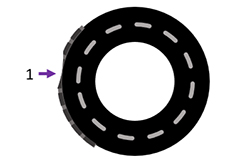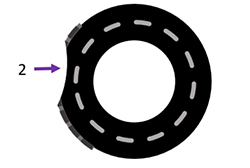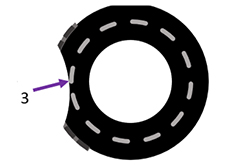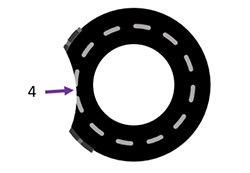Commercial motor vehicle inspectors in Canada, Mexico and the U.S. conducted 10,091 inspections and placed 1,273 vehicles out of service for brake-related critical vehicle inspection items on May 26. Inspectors tracked and reported this data to the Commercial Vehicle Safety Alliance (CVSA) for Brake Safety Day, the Alliance’s unannounced one-day inspection and enforcement initiative focused on brake systems.
“Inspectors conducted their usual inspections and reported brake-related data to CVSA for Brake Safety Day,” said CVSA President Sgt. John Samis with the Delaware State Police. “We are sharing the results to call attention to the importance of commercial motor vehicle brake safety.”
Why does CVSA devote an inspection day specifically to brakes? Brakes are one of the most important systems within a commercial motor vehicle; however, despite our knowledge of how crucial those systems are, brake-related violations continue to dominate vehicle out-of-service conditions. Brake system violations was the top vehicle out-of-service category during last year’s three-day International Roadcheck commercial motor vehicle and driver inspection and enforcement safety initiative.
Each year, for Brake Safety Day, CVSA-certified inspectors conduct inspections, focusing on the vehicle’s brake systems and components, and remove commercial motor vehicles with brake-related out-of-service violations from roadways. Here are the results from May 26:
- Six jurisdictions from Canada, 42 U.S. jurisdictions, and Mexico’s Ministry of Communications and National Guard participated.
- Inspectors in Canada, Mexico and the U.S. conducted 10,091 inspections and placed 1,273 vehicles out of service for brake violations.
- The brake-related out-of-service rate in North America was 12.6%.
- The U.S. brake-violation out-of-service rate was 13.3%. In Canada, the rate was 11.4% and in Mexico, the rate was 2.9%.
- In Canada, 946 inspections were conducted. In Mexico, inspectors conducted 487 inspections, and in the U.S., 8,658 inspections were conducted.
- Fourteen vehicles were removed from roadways in Mexico for brake violations. In Canada, 108 vehicles were placed out of service for brake violations, and in the U.S., 1,151 vehicles had to be removed from roadways due to brake violations.
In addition, inspectors compiled and reported data specifically on brake hoses/tubing, the focus area for this year’s Brake Safety Day. Canada, Mexico and the U.S. reported a total of 1,725 brake hoses/tubing violations from the one-day unannounced brake safety initiative. Broken out by country: Canada reported 251 chafing violations, Mexico reported 186 and the U.S. reported 1,288.
CVSA asked inspectors to submit data on five different brake hose/tubing chafing violations:
- Category 1 violations were defined as brake hose/tubing wear that had extended into the outer protective material. Thirty-eight percent (664) of brake hose chafing violations met that definition. This is not an out-of-service condition.
- A category 2 violation means wear had extended through the brake hose/tubing outer protective material into the outer rubber cover. Thirty percent (509) of brake hose chafing violations were category 2. Category 2 violations are not out-of-service conditions.
- When the brake hose/tubing wear makes the reinforcement ply visible, but the ply is still intact, that is a category 3 violation. Sixteen percent (275) of brake hose chafing violations were category 3. This is not an out-of-service condition.
- A category 4 violation is when the reinforcement ply is visible and the ply is completely frayed, severed or cut through. Ten percent (169) of brake hose chafing violations were category 4. Vehicles with category 4 chafed hose conditions were placed out of service.
- Brake hose/tubing wear for category 5 violations extended through the reinforcement ply to the inner rubber layer. Six percent (108) of brake hose chafing violations were identified as category 5, which is an out-of-service condition.
Table 1: Percentage of Brake Hose Chafing Violations
Table 2: Number of Brake Hose Chafing Violations
| Country | Category 1 | Category 2 | Category 3 | Category 4 | Category 5 | Total |
| Canada | 118 | 76 | 34 | 12 | 11 | 251 |
| Mexico | 104 | 42 | 33 | 5 | 2 | 186 |
| U.S. | 442 | 391 | 208 | 152 | 95 | 1,288 |
| Total | 664 | 509 | 275 | 169 | 108 | 1,725 |
“Brake hoses and tubing are essential brake system components and must be properly attached, undamaged, without leaks and flexible,” said Sgt. Samis. “We chose to focus on brake hoses/tubing this year in an effort to reduce deaths and injuries as a result of commercial motor vehicle brake-system failures from pressure or vacuum loss due to brake hose/tubing deficiencies.”
Some jurisdictions in the U.S. use performance-based brake testers (PBBT) as part of their vehicle inspection process. A PBBT is a machine that assesses the braking performance of a vehicle. On Brake Safety Day, 68 PBBT tests were conducted. Four percent of PBBT-tested commercial motor vehicles were placed out of service for insufficient brake performance.
Brake Safety Day is the Alliance’s unannounced brake safety initiative; however, CVSA also holds Brake Safety Week each year and announces those dates publicly well in advance. This year’s Brake Safety Week is scheduled for Aug. 22-28.
Brake Safety Day and Brake Safety Week are part of CVSA’s Operation Airbrake program in partnership with the U.S. Federal Motor Carrier Safety Administration, the Canadian Council of Motor Transport Administrators, and Mexico’s Ministry of Communications and the National Guard. Operation Airbrake is a comprehensive program dedicated to improving commercial motor vehicle brake safety throughout North America. The goal is to reduce the number of highway crashes caused by faulty braking systems on commercial motor vehicles by conducting roadside inspections and educating drivers, mechanics, owner-operators and others on the importance of proper brake inspection, maintenance and operation.





